With a past that pre-dates the city itself, Rome’s Palatine Hill holds an important place in the history of the Eternal City. Today only ruins remain but during the Imperial era, the hill was completely built up with large palaces.
Rome’s Origins
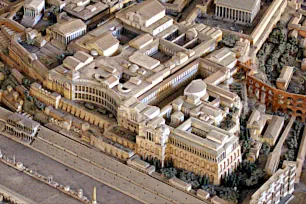
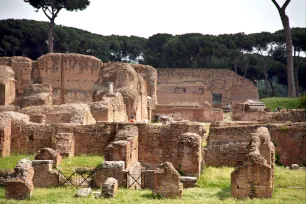
Palatine Hill is the centermost of the famous seven hills of Rome. Located in between such attractions as the Circus Maximus, the Colosseum, and the Roman Forum, evidence from archaeological digs demonstrates that the hill was inhabited as long ago as the tenth century BC.
The hill has a strong link to Roman mythology. It is believed that on Palatine Hill, the twins Romulus and Remus were found in the Lupercal Cave by their four-legged shepherd mother, who raised them. Ultimately, this is where Romulus decided to build the city.
Therefore, it was on this hill that the Roman Empire began.
History
By the time of Rome’s Republican era, Palatine Hill became the fashionable place to live, due partly to the amazing views on the top of the hill, which stretches to a height of about seventy meters (230 feet) above the city. It was also believed – and accurately so, according to historians – that the air was cleaner atop the hill and that those who lived on it were less likely to catch the diseases of the working class that festered in the bad air below.
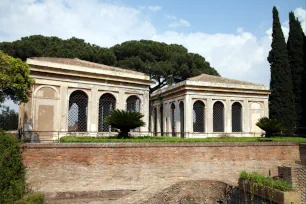
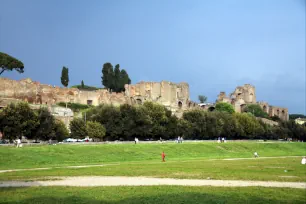
Augustus, Cicero, and Marc Antony (Marcus Antonius) all had homes on the hill. Later, emperors built their domains here and, at one point, the entire hill was covered with imperial palaces. The hill became synonymous with palaces; in fact in many languages, including English, the word ‘palace’ is derived from ‘palatine’.
During the Middle Ages, churches and convents were built on Palatine Hill. Later, almost the entire hill was owned by Cardinal Alessandro Farnese, who created an ornate botanical garden on top of the ruins.
Excavation site
Archaeological excavation has been taking place on Palatine Hill since the mid to late eighteenth century. Evidence of a Bronze Age settlement has become apparent and archaeologists have discovered what they have dubbed the Palatine House, where they believe Rome’s first emperor, Augustus, was born. It remains just one of a few early Republican houses that weren’t overbuilt by imperial palaces.
Because so much of the hill is an excavation site, the best look at what the hill may have been like comes via the Palatine Antiquarium Museum, located on top of Domitian’s Palace. In the museum’s nine rooms, you’ll find ceramics, frescoes, mosaics, inscriptions, sculptures and portrait heads actually found on the hill.
The Ruins
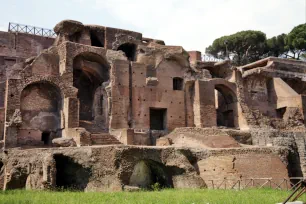


The Palatine Hill is littered with ruins from ancient palaces and other buildings.
At the southern end, bordering Circus Maximus, are the remains of the palace of Septimius Severus, Roman emperor between 193 and 211 AD. Adjacent to the palace lie the ruins of the Baths of Septimius Severus.
Just north of the palace of Septimius Severus is the so-called stadium. It is not clear if this area was actually a public or private stadium, or that it was used as a private imperial garden.
The stadium was built together with the Palace of Domitian, which formed the heart of the Palatine Hill. For three centuries the palace, built in 81 AD, held the title of Rome’s largest palace. Domitian’s Palace was constructed between two crests after the tallest one – the Palatium – was topped off and the ground used to level the hilltop. The palace consisted of two wings: a private one (the Domus Augustana) and a public one (the Domus Flavia). Remains of both wings can still be found.
Just north-west of the Domus Flavia is the House of Livia, one of the best preserved houses on the Palatine Hill. The house dates back to the 1st century BC and was the home of Emperor Augustus and his wife Livia.

Archaeologists also discovered remains of an early settlement on the Palatine Hill, probably dating back to the times of the first king of Rome, Romulus. Hence, this site is known as the Hut of Romulus.
Other ruins found on the Palatine Hill include the House of Augustus, the Temple of Apollo and the Temple of Cybele.
Farnese Garden
At the north-west end of the Palatine Hill are the ruins of the Palace of Tiberius (aka Palace of Caligula), built in the 1st century AD. Not much is left of it, however, since cardinal Allessandro Farnese acquired the area in 1550 and decided to fill in the ruins and build a garden on top of it. It was one of the first botanical gardens in Europe, featuring many rare plants. The garden was connected to the Roman Forum via several flights of stairs.
- Next: Arch of Titus
- More Rome Ancient Sights
- More Sights & Attractions in Rome

